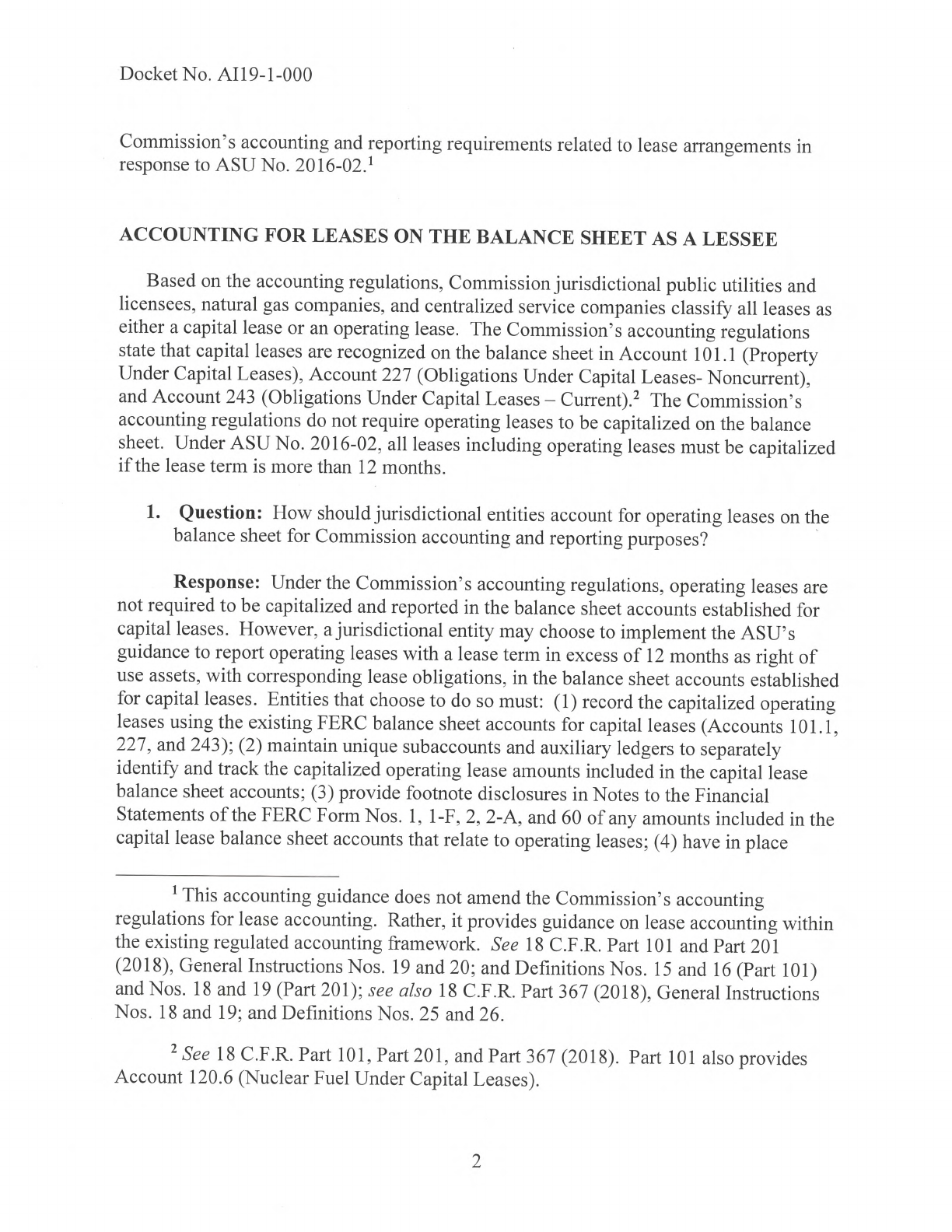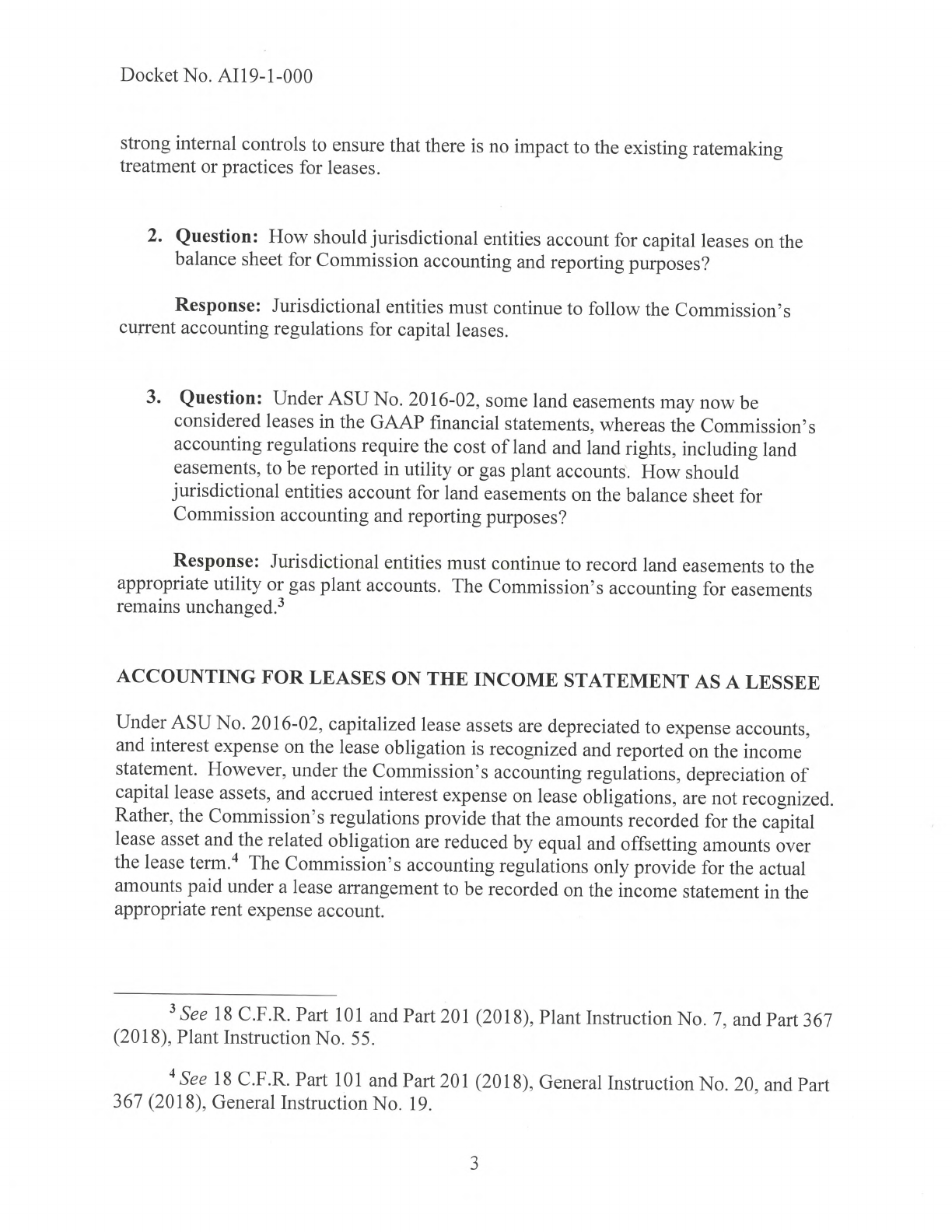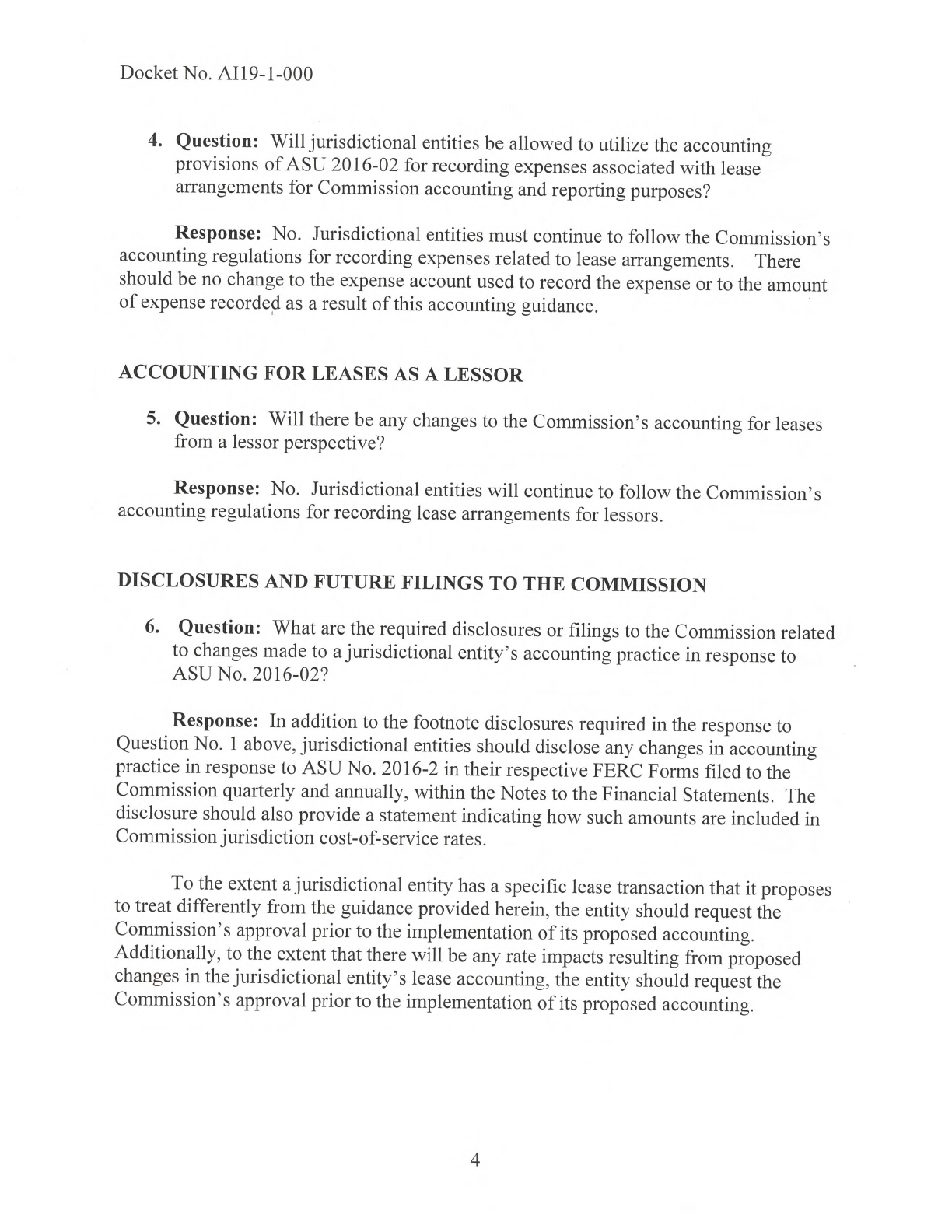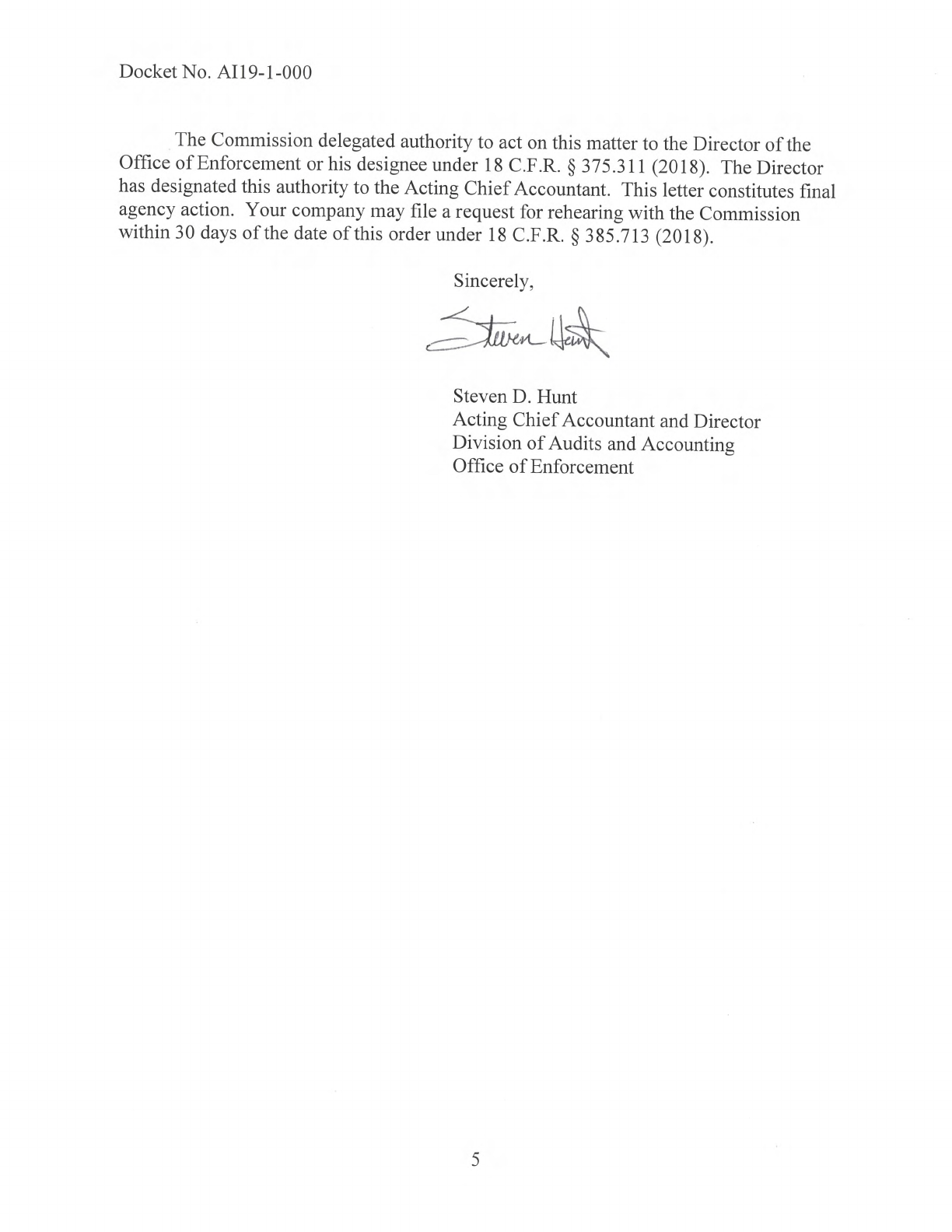
FEDERAL ENERGY REGULATORY COMMISSION
Washington, D.C. 20426
In Reply Refer To:
Office of Enforcement
Docket No. AI19-1-000
December 27, 2018
TO ALL JURISDICTIONAL PUBLIC UTILITIES AND LICENSEES, NATURAL
GAS COMPANIES, AND CENTRALIZED SERVICE COMPANIES
Subject:
Accounting and Financial Reporting for Leases
The Financial Accounting Standards Board (FASB) has issued Accounting
Standards Update (ASU) No. 2016-02,
Leases (Topic 842).
ASU No. 2016-02 amends
FASB Accounting Standards Codification, Topic 840,
Leases,
with the intent to increase
transparency and comparability among organizations by recognizing lease assets and
lease liabilities on the balance sheet and disclosing key information about leasing
arrangements. Under the FASB's new guidance, lessees are required to recognize on the
balance sheet the assets and liabilities for the rights and obligations created by lease
arrangements for operating leases with terms of more than 12 months. ASU No. 2016-02
is generally effective January 1, 2019 for generally accepted accounting principles
(GAAP) purposes. Commission staff received a number of inquiries from industry
participants regarding clarification on how to apply this ASU for purposes of regulatory
accounting and reporting to the Commission. The commenters sought clarity on how to
implement FASB's new lease accounting guidance within the framework and regulatory
intent of the Commission's existing requirements for lease accounting.
As discussed herein, jurisdictional entities will be permitted to record operating leases
that may be capitalized under ASU No. 2016-02 in the FERC balance sheet accounts that
have already been established for capital lease assets and liabilities. All other provisions
of lease accounting are not affected by this accounting guidance. This accounting
guidance is intended to have no impact on the existing ratemaking treatment or practices.
The Commission's accounting requirements are not intended to mirror changes in
FASB's Accounting Standards Codification, and the FASB updates should not be
construed as required for regulatory accounting and reporting to the Commission.
However, upon analysis, the Commission may issue accounting guidance to clarify how
provisions of an ASU can be reflected within the Commission's existing accounting and
financial reporting requirements. Accordingly, this accounting issuance is intended to
provide clarity and certainty on how jurisdictional entities should apply the

Docket No. An 9-1-000
Commission's accounting and reporting requirements related to lease arrangements in
response to ASU No. 2016-02.
1
ACCOUNTING FOR LEASES ON THE BALANCE SHEET AS A LESSEE
Based on the accounting regulations, Commission jurisdictional public utilities and
licensees, natural gas companies, and centralized service companies classify all leases as
either a capital lease or an operating lease. The Commission's accounting regulations
state that capital leases are recognized on the balance sheet in Account 101.1 (Property
Under Capital Leases), Account 227 (Obligations Under Capital Leases- Noncurrent),
and Account 243 (Obligations Under Capital Leases — Current).
2
The Commission's
accounting regulations do not require operating leases to be capitalized on the balance
sheet. Under ASU No. 2016-02, all leases including operating leases must be capitalized
if the lease term is more than 12 months.
1.
Question:
How should jurisdictional entities account for operating leases on the
balance sheet for Commission accounting and reporting purposes?
Response:
Under the Commission's accounting regulations, operating leases are
not required to be capitalized and reported in the balance sheet accounts established for
capital leases. However, a jurisdictional entity may choose to implement the ASU's
guidance to report operating leases with a lease term in excess of 12 months as right of
use assets, with corresponding lease obligations, in the balance sheet accounts established
for capital leases. Entities that choose to do so must: (1) record the capitalized operating
leases using the existing FERC balance sheet accounts for capital leases (Accounts 101.1,
227, and 243); (2) maintain unique subaccounts and auxiliary ledgers to separately
identify and track the capitalized operating lease amounts included in the capital lease
balance sheet accounts; (3) provide footnote disclosures in Notes to the Financial
Statements of the FERC Form Nos. 1, 1-F, 2, 2-A, and 60 of any amounts included in the
capital lease balance sheet accounts that relate to operating leases; (4) have in place
This accounting guidance does not amend the Commission's accounting
regulations for lease accounting. Rather, it provides guidance on lease accounting within
the existing regulated accounting framework.
See
18 C.F.R. Part 101 and Part 201
(2018), General Instructions Nos. 19 and 20; and Definitions Nos. 15 and 16 (Part 101)
and Nos. 18 and 19 (Part 201);
see also
18 C.F.R. Part 367 (2018), General Instructions
Nos. 18 and 19; and Definitions Nos. 25 and 26.
See
18 C.F.R. Part 101, Part 201, and Part 367 (2018). Part 101 also provides
Account 120.6 (Nuclear Fuel Under Capital Leases).
2

Docket No. AI19-1-000
strong internal controls to ensure that there is no impact to the existing ratemaking
treatment or practices for leases.
2.
Question:
How should jurisdictional entities account for capital leases on the
balance sheet for Commission accounting and reporting purposes?
Response:
Jurisdictional entities must continue to follow the Commission's
current accounting regulations for capital leases.
3.
Question:
Under ASU No. 2016-02, some land easements may now be
considered leases in the GAAP financial statements, whereas the Commission's
accounting regulations require the cost of land and land rights, including land
easements, to be reported in utility or gas plant accounts. How should
jurisdictional entities account for land easements on the balance sheet for
Commission accounting and reporting purposes?
Response:
Jurisdictional entities must continue to record land easements to the
appropriate utility or gas plant accounts. The Commission's accounting for easements
remains unchanged.
3
ACCOUNTING FOR LEASES ON THE INCOME STATEMENT AS A LESSEE
Under ASU No. 2016-02, capitalized lease assets are depreciated to expense accounts,
and interest expense on the lease obligation is recognized and reported on the income
statement. However, under the Commission's accounting regulations, depreciation of
capital lease assets, and accrued interest expense on lease obligations, are not recognized.
Rather, the Commission's regulations provide that the amounts recorded for the capital
lease asset and the related obligation are reduced by equal and offsetting amounts over
the lease terrn.
4
The Commission's accounting regulations only provide for the actual
amounts paid under a lease arrangement to be recorded on the income statement in the
appropriate rent expense account.
3
See
18 C.F.R. Part 101 and Part 201
(2018), Plant Instruction No. 55.
4
See
18 C.F.R. Part 101 and Part 201
367 (2018), General Instruction No. 19.
(2018), Plant Instruction No. 7, and Part 367
(2018), General Instruction No. 20, and Part
3

Docket No. AI19-1-000
4.
Question:
Will jurisdictional entities be allowed to utilize the accounting
provisions of ASU 2016-02 for recording expenses associated with lease
arrangements for Commission accounting and reporting purposes?
Response:
No. Jurisdictional entities must continue to follow the Commission's
accounting regulations for recording expenses related to lease arrangements. There
should be no change to the expense account used to record the expense or to the amount
of expense recorded as a result of this accounting guidance.
ACCOUNTING FOR LEASES AS A LESSOR
5.
Question:
Will there be any changes to the Commission's accounting for leases
from a lessor perspective?
Response:
No. Jurisdictional entities will continue to follow the Commission's
accounting regulations for recording lease arrangements for lessors.
DISCLOSURES AND FUTURE FILINGS TO THE COMMISSION
6.
Question:
What are the required disclosures or filings to the Commission related
to changes made to a jurisdictional entity's accounting practice in response to
ASU No. 2016-02?
Response:
In addition to the footnote disclosures required in the response to
Question No. 1 above, jurisdictional entities should disclose any changes in accounting
practice in response to ASU No. 2016-2 in their respective FERC Forms filed to the
Commission quarterly and annually, within the Notes to the Financial Statements. The
disclosure should also provide a statement indicating how such amounts are included in
Commission jurisdiction cost-of-service rates.
To the extent a jurisdictional entity has a specific lease transaction that it proposes
to treat differently from the guidance provided herein, the entity should request the
Commission's approval prior to the implementation of its proposed accounting.
Additionally, to the extent that there will be any rate impacts resulting from proposed
changes in the jurisdictional entity's lease accounting, the entity should request the
Commission's approval prior to the implementation of its proposed accounting.
4

Docket No. AI19-1-000
The Commission delegated authority to act on this matter to the Director of the
Office of Enforcement or his designee under 18 C.F.R. § 375.311 (2018). The Director
has designated this authority to the Acting Chief Accountant. This letter constitutes final
agency action. Your company may file a request for rehearing with the Commission
within 30 days of the date of this order under 18 C.F.R. § 385.713 (2018).
Sincerely,
Steven D. Hunt
Acting Chief Accountant and Director
Division of Audits and Accounting
Office of Enforcement
5
